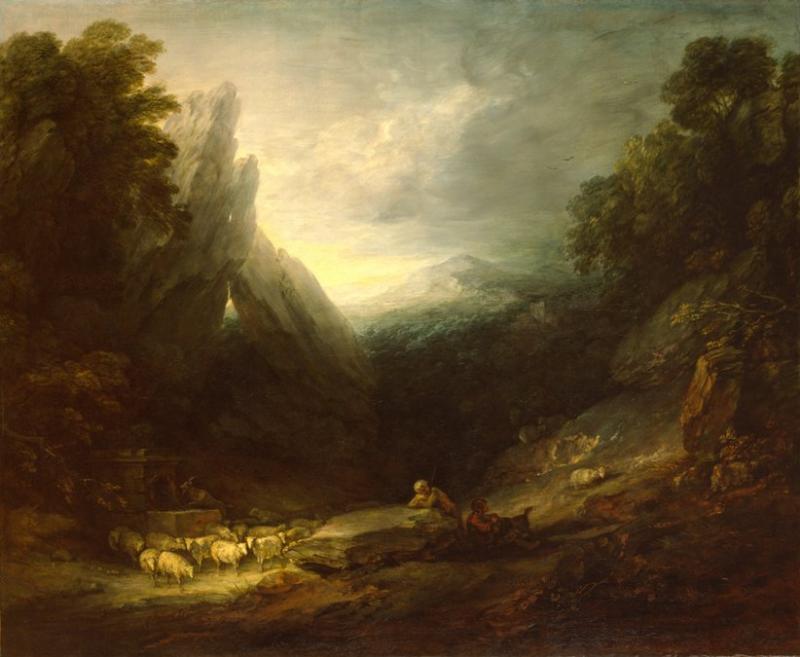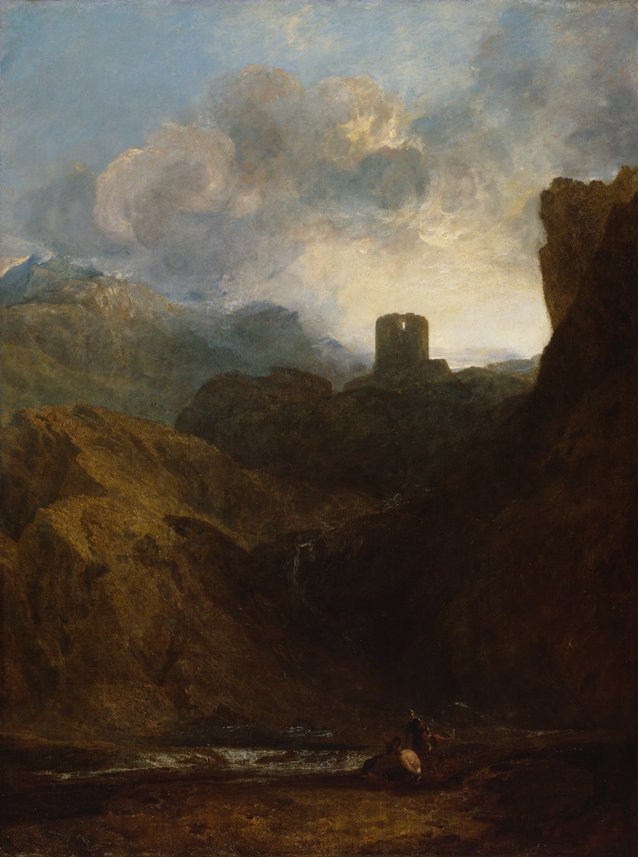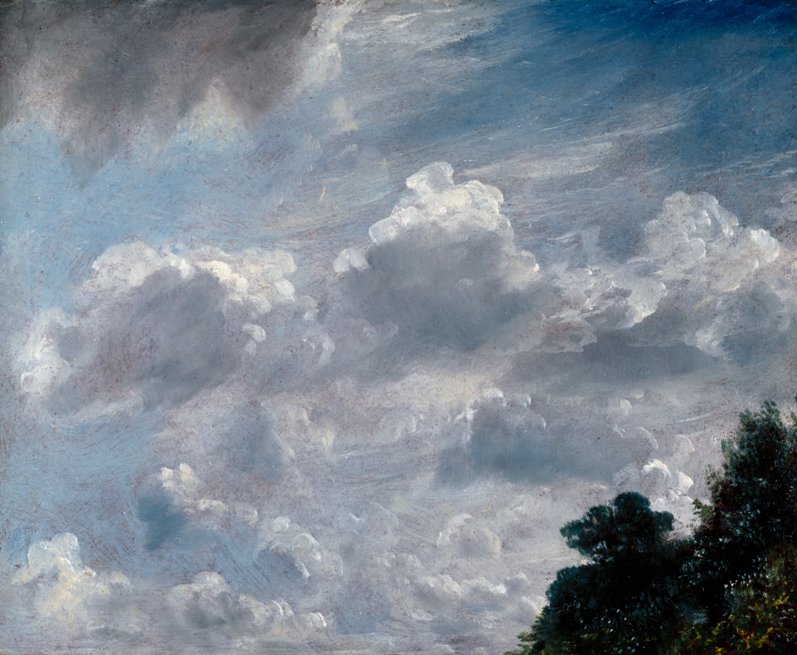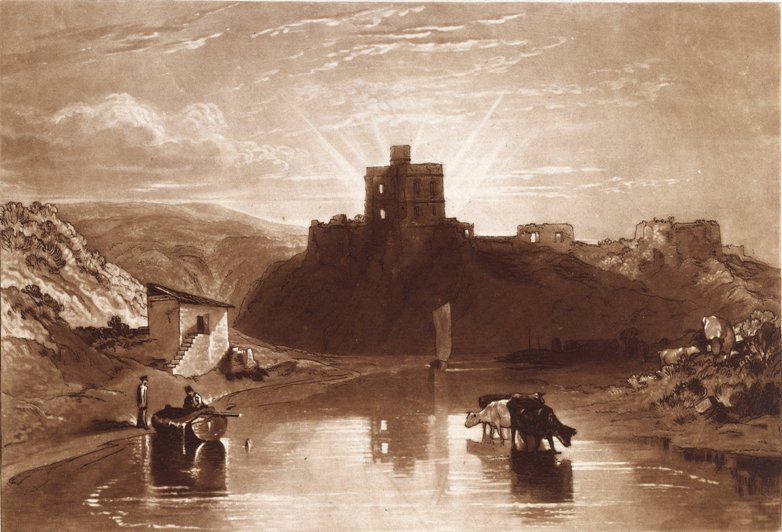Constable, Gainsborough, Turner and the Making of Landscape, Royal Academy | reviews, news & interviews
Constable, Gainsborough, Turner and the Making of Landscape, Royal Academy
Constable, Gainsborough, Turner and the Making of Landscape, Royal Academy
The great British painters' love of the great outdoors

All roads start from Rome, and so it proves in this challenging exhibition put together from the holdings of the Royal Academy’s art collection, archives and library. It features 17th-century Italian paintings – some of the grandest by the French artists who settled in Rome, and took inspiration from the surrounding campagna – brought back to Britain by the Grand Tourists who, in the midst of their various adventures, amassed substantial art for their stately homes.
The images by the likes of the two Poussins (Nicolas, and his brother-in-law Gaspard Dughet, so often confused), Claude Lorrain and the tempestuous Salvator Rosa were disseminated by means of highly technically accomplished and refined engravings, etchings and mezzotints to an increasingly wide audience of the cultivated and the artistic. This development helped to seed artistic vision in this country just in time for the founding of the Royal Academy in 1768 under the enlightened patronage of George III.
 Three pioneers are mostly represented here by reproductive prints: the Welshman Richard Wilson, who spent seven years in Italy, is typically labelled the father of British landscape painting (and was destroyed by drink); Thomas Smith of Derby, who has been forgotten by all but art historians; and Paul Sandby, topographer and watercolourist, memorialist of Windsor and its park who also travelled through much of England and Wales.
Three pioneers are mostly represented here by reproductive prints: the Welshman Richard Wilson, who spent seven years in Italy, is typically labelled the father of British landscape painting (and was destroyed by drink); Thomas Smith of Derby, who has been forgotten by all but art historians; and Paul Sandby, topographer and watercolourist, memorialist of Windsor and its park who also travelled through much of England and Wales.
The era did not simply create a taste for landscape for its own sake. The observed landscape – the canalised Suffolk landscape in Constable’s marvellous A Boat Passing a Lock, and his great six-footer The Leaping Horse (main image) – was always marked by man, by buildings, architectural features and, even in Gainsborough’s brooding and atmospheric Romantic Landscape, a load of sheep. People appear too, often appropriately mythologised, as in Wilson’s inspirational The Destruction of Niobe and Her Children, here in a 1761 engraving by William Woollett. Turner’s Welsh-set Dolbadern Castle, 1800 (pictured above right), painted when he was 25, was his Diploma painting, the artwork all Academicians have to deposit on election. He was a true prodigy, a student at the RA Schools at 14 and elected early. By contrast Constable was a late developer, concerned that landscape was not as prestigious as history painting. But here his cloud studies enchant - he was as fascinated by clouds as Turner was by the sun. (Pictured below left: Constable's Cloud Study, Hampstead, Tree at Right, 1821).
 The visual genius of Turner and Constable is revealed in both a passionate, obsessive attention to landscape - symbolic, observed, painted, drawn, and reproduced in print by themselves and others (the last being a nice little earner). They were fully aware of both past and present, entering into the debates concerning the sublime or the romantic as the emotional moods sought in landscape. There were arguments too about cultivating the picturesque, or what kind of beauty was to be sought. Turner admired Wilson, even seeking out his grave to offer homage.
The visual genius of Turner and Constable is revealed in both a passionate, obsessive attention to landscape - symbolic, observed, painted, drawn, and reproduced in print by themselves and others (the last being a nice little earner). They were fully aware of both past and present, entering into the debates concerning the sublime or the romantic as the emotional moods sought in landscape. There were arguments too about cultivating the picturesque, or what kind of beauty was to be sought. Turner admired Wilson, even seeking out his grave to offer homage.
Gainsborough meanwhile felt trapped by portraiture, the genre that made his name, professing a passionate love of landscape even if many of his images were based on observation filtered at times almost unrecognisably through imagination. Here was an intellectual romp carried out energetically in the invention of new kinds of imagery, inspired too by an understanding of Dutch rusticities.
 All this is on the walls of the RA, complemented by personal memorabilia: Turner’s fishing rod, not to mention his travelling watercolour box, Constable’s palette, letters from Gainsborough to other artists. The holdings of the RA are rich and various, and not always on view, so this reminder of the collections and archival scholarship which underlies this artists’ collective is welcome, including portraits of Gainsborough, Turner and Constable.
All this is on the walls of the RA, complemented by personal memorabilia: Turner’s fishing rod, not to mention his travelling watercolour box, Constable’s palette, letters from Gainsborough to other artists. The holdings of the RA are rich and various, and not always on view, so this reminder of the collections and archival scholarship which underlies this artists’ collective is welcome, including portraits of Gainsborough, Turner and Constable.
And as is all too visible, the major trio at the RA all exploited printmaking in various ways to disseminate their work, and enlarge their earnings. (Pictured above right: Turner's Norham Castle on the Tweed, 1816, etching and mezzotint). The examination of the burgeoning of landscape as a subject in its own right, and not always needing a leavening of myth or history to be taken seriously, is fascinating. But oh for some marvellous bursts of painting to alleviate a seemingly endless procession of beautifully detailed and meticulous prints: they make their point – again and again.
Share this article
The future of Arts Journalism
You can stop theartsdesk.com closing!
We urgently need financing to survive. Our fundraising drive has thus far raised £49,000 but we need to reach £100,000 or we will be forced to close. Please contribute here: https://gofund.me/c3f6033d
And if you can forward this information to anyone who might assist, we’d be grateful.

Subscribe to theartsdesk.com
Thank you for continuing to read our work on theartsdesk.com. For unlimited access to every article in its entirety, including our archive of more than 15,000 pieces, we're asking for £5 per month or £40 per year. We feel it's a very good deal, and hope you do too.
To take a subscription now simply click here.
And if you're looking for that extra gift for a friend or family member, why not treat them to a theartsdesk.com gift subscription?
more Visual arts
 'We are bowled over!' Thank you for your messages of love and support
Much-appreciated words of commendation from readers and the cultural community
'We are bowled over!' Thank you for your messages of love and support
Much-appreciated words of commendation from readers and the cultural community
 Folkestone Triennial 2025 - landscape, seascape, art lovers' escape
Locally rooted festival brings home many but not all global concerns
Folkestone Triennial 2025 - landscape, seascape, art lovers' escape
Locally rooted festival brings home many but not all global concerns
 Sir Brian Clarke (1953-2025) - a personal tribute
Remembering an artist with a gift for the transcendent
Sir Brian Clarke (1953-2025) - a personal tribute
Remembering an artist with a gift for the transcendent
 Emily Kam Kngwarray, Tate Modern review - glimpses of another world
Pictures that are an affirmation of belonging
Emily Kam Kngwarray, Tate Modern review - glimpses of another world
Pictures that are an affirmation of belonging
 Kiefer / Van Gogh, Royal Academy review - a pairing of opposites
Small scale intensity meets large scale melodrama
Kiefer / Van Gogh, Royal Academy review - a pairing of opposites
Small scale intensity meets large scale melodrama
 Jenny Saville: The Anatomy of Painting, National Portrait Gallery review - a protégé losing her way
A brilliant painter in search of a worthwhile subject
Jenny Saville: The Anatomy of Painting, National Portrait Gallery review - a protégé losing her way
A brilliant painter in search of a worthwhile subject
 Abstract Erotic, Courtauld Gallery review - sculpture that is sensuous, funny and subversive
Testing the boundaries of good taste, and winning
Abstract Erotic, Courtauld Gallery review - sculpture that is sensuous, funny and subversive
Testing the boundaries of good taste, and winning
 Edward Burra, Tate Britain review - watercolour made mainstream
Social satire with a nasty bite
Edward Burra, Tate Britain review - watercolour made mainstream
Social satire with a nasty bite
 Ithell Colquhoun, Tate Britain review - revelations of a weird and wonderful world
Emanations from the unconscious
Ithell Colquhoun, Tate Britain review - revelations of a weird and wonderful world
Emanations from the unconscious
 Rachel Jones: Gated Canyons, Dulwich Picture Gallery review - teeth with a real bite
Mouths have never looked so good
Rachel Jones: Gated Canyons, Dulwich Picture Gallery review - teeth with a real bite
Mouths have never looked so good
 Yoshitomo Nara, Hayward Gallery review - sickeningly cute kids
How to make millions out of kitsch
Yoshitomo Nara, Hayward Gallery review - sickeningly cute kids
How to make millions out of kitsch
 Hamad Butt: Apprehensions, Whitechapel Gallery review - cool, calm and potentially lethal
The YBA who didn’t have time to become a household name
Hamad Butt: Apprehensions, Whitechapel Gallery review - cool, calm and potentially lethal
The YBA who didn’t have time to become a household name

Add comment